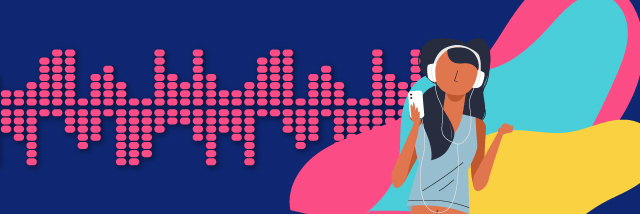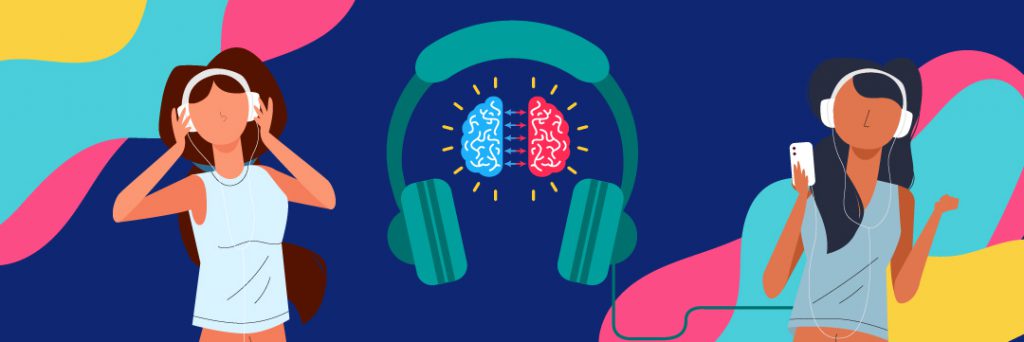“8d audio, please wear headphones.” You’ve probably seen this on YouTube. It’s like a warning sign “8d audio ahead, listeners beware!”
So what is this 8d audio that has the entire internet going crazy?
8d audio aims to create the illusion of a 360 degree sound that moves in circles around your head. This is achieved by mixing the audio and adding spatial reverb.
It makes you feel like you are listening to a live performance of the song. This is why YouTube is now full of edited songs that have 8d audio. But why go through the trouble?
But if you prefer to watch a video instead, click here:
This post was updated in April 2021
The Real Meaning of 8d Audio
Let’s break your bubble right here: 8d audio does not actually have 8 dimensions. You have been lied to. 8D is just another term YouTubers have coined to get you to listen to their music and subscribe to their channels.
But there is something else…
Depending on how it is done, 8d audio can really make you feel like you are in another dimension.
Pros of 8d music:
- It makes audio more relaxing.
- It makes you feel like you are in the middle of a live performance.
Cons of 8d audio
- If mixed poorly, 8d sound can make you feel nauseous or even dizzy.
We process sounds in three dimensions. This is how we can tell whether a sound is coming from behind us or above us or in front of us.
The literal definition of 8d sound would place the source of the audio all around us, so technically, its another word for surround sound _ only 8d audio has more spatial reverb and you can only hear it on headphones.
Where To Find 8d Sound
YouTube, as always. It’s free, and it has a large collection of 8d music you can choose from. On this platform, independent creators edit popular songs by famous artists into 8d sound.
However, artists can also choose to create original 8d tracks.
Online streaming services like Spotify offer catalogs of 8D music, but they are mostly original works or instrumentals and rarely edited versions of old tracks.

Need 8d audio experts? Find samples of their work or submit a project with Bunny Studio today!
How Does it All Work?
Have you ever seen a painting that plays with depth perception?
Some artists paint roads or elevators to look like sinkholes, and it makes you wonder: how can you achieve that in a three-dimensional world?
It’s all about perception: fooling the brain to believing it has heard or seen something that doesn’t actually exist. Well, the same idea applies to 8d audio.
You can hear 8d audio, but it’s not real.
It’s probably obvious, but here are a few things you need to know:
- A sound originating from your right side hits your right ear faster than it hits your left.
- If you add in the echo and reverberation used in 8d sound, it seems like the audio is bouncing off objects in your environment.
- Audio filtering measures the change in sound quality as it bounces from one ear to the other. This quality can even be influenced by the shape of your head.
With these factors in mind, you can see that it is easy to manipulate audio so it sounds like it’s coming from a specific point in a 360-degree virtual place.
8D effects are really just 3D audio effects that work a little harder to provide an immersive listening experience.
Why You Need Headphones
To make the illusion of 8d audio real, you need headphones. This is because headphones can isolate what you hear in each ear.
We know what you’re thinking: why can’t speakers do the same thing? It is not the same phenomenon of bouncing sound from one side to the other?
Crosstalk
Well, with speakers, it’s difficult for the brain to locate where exactly the sound is coming from. This is because of something called crosstalk.
When using headphones, the sound from one ear-cup cannot extend to the other side. With speakers, you hear the sound from both speakers simultaneously in both ears _ this is crosstalk. Ultimately, it means you cannot tell where exactly the sound is coming from.
Therefore, headphones are not mini speakers fixed on the side of your head; the two work in different ways.
8D Audio is not Surround Sound
Here lies the major difference between surround sound and 8D audio: crosstalk.
Surround sound speakers have as many as seven-channel speakers that are all positioned around the listener in an attempt to add some depth to the audio.
The speakers have to placed above, behind, in front, and beside the listener. More to this, you have to closely monitor the sound that comes from each speaker.
It’s easier to achieve sound depth with 8D audio.
How to Make 8d Audio
There is no 8D microphone of special equipment you use to record this sound. All the music you see on YouTube has not been re-recorded _ it’s all just digital mixing.
There are two main steps involved:
Reverb
The first step is to apply a reverb effect to the audio. This adds spatial reflections and echoes to the sound so it feels like its being played in a large hall.
It about making your brain believe that the sound is coming from a bigger space.
You are still listening to stereo: it’s just been manipulated to sound like it’s rotating around your head.
Moving the Audio
The second step is about creating the illusion of movement. The creator manipulates various parts of the audio to make it seem like it’s moving around in a 360-degree virtual space.
Before the trend caught on, 8D audio used to be just about panning sound from one ear to the other. But times have changed, and 3D audio software is much more advanced now.
Great 8D audio must have this quality:
Subtle sound movements
Yes, the whole idea of 8D audio involves bouncing sound from one ear to another to create the illusion of 360-degree audio.
However, great 8D sound makes you feel like you are physically swaying around in a concert hall. The music is supposed to sound like it is in the room with you, only its in your headphones.
8D Audio is not New
This phenomenon of manipulating audio has been around for over a century.
Traditionally, 8D audio was created by manually moving a sound source around a set of microphones. This was before the invention of 3D audio tools that can achieve the same effect without much hustle.
However, as far as anyone can tell, there is no real difference between 8d audio and the rest: we are talking about 9D, 16D, 24D, 48D, and 100D sounds.
Which leads us to the next big question: is 8D audio the future of sound?
The Future of 8D Sound
Let’s look at the facts of 8d audio before deciding the future of the sound:
It doesn’t work without headphones
This is the first red flag: 8D audio might not last. It’s not real, and you cannot experience it without headphones.
It’s tiring
The sound is perpetually moving. If done wrong, it can be nauseating. But even if 8D audio is well done, all the moving sound can be tiring to the ears.
Is it even legal?
Most 8D tracks on YouTube are essentially remixes of original songs. This might not be entirely legal since it is unsanctioned by the creator of the song.
Spatial Audio
Have you ever heard of spatial audio?
Instead of creating the illusion of movement, spatial audio expands the soundstage by physically placing the sound source all around the listener. You can further enhance spatial sound by manipulating the volume and direction of the sound.
Here is an in-depth article about spatial audio.
8D vs Binaural Audio
The phenomenon behind the two sounds is the same. Binaural music creates a pulsating sound by sending audio to the right and left ear at different frequencies. This makes some listeners feel relaxed or more focused on their tasks.
You can record binaural audio using a 3D audio microphone. This allows you to experience the full 360-degree sound illusion without mixing the audio or using filters.
Binaural sound also needs headphones to be heard.

Is 8D Audio Dangerous?
If you’re wondering if there are any side effects to listening to 8D audio, here’s your answer:
No.
You can safely listen to 8D music just as you can listen to any other sound. Also, there is no such thing as 8D music; something cant hurt you if it doesn’t exist, right?
However, listeners have complained about 8D sound being annoying or distracting. They claim that the most distracting aspect of 8D is the altered speed and frequency of the sound.
On the contrary, other listeners claim that they connected with 8D audio more than they have ever connected with any other sound before. They describe listening to the sound as an out-of-body experience.
At worst, you will be uncomfortable listening to the audio because of the mixing, but you should be safe.
Remember to listen at the appropriate volume on your headphones: too loud sounds can damage your eardrum.
What Do You Think?
So what do you think? Is 8D audio a gimmick or is it the future of sound?
Normal stereo audio directs sound to the left and right speaker channels. The 8D effects make it seem like the sound is in space so you hear it in your brain and not your ears.
8D also audio goes well with ethereal music as opposed to poppy songs. Ethereal music already has a calm ambiance, and it’s easy for the 8D effect to enhance that. The effect is both physically and mentally soothing is used right.
Whether 8D audio is here to stay or not, it has changed the way we experience sounds and music.
If you need help creating the ideal ad, find samples of 8D audio or 8D video, submit a project with us today!









